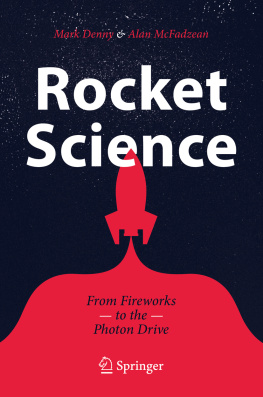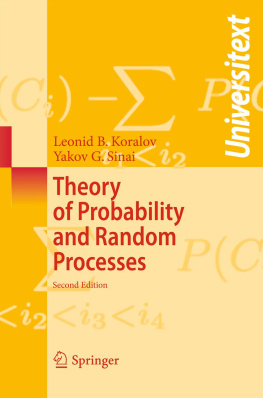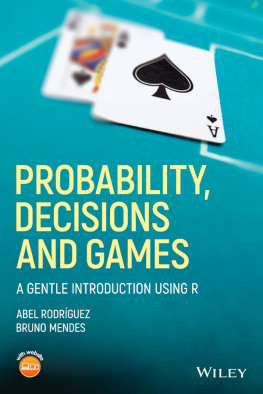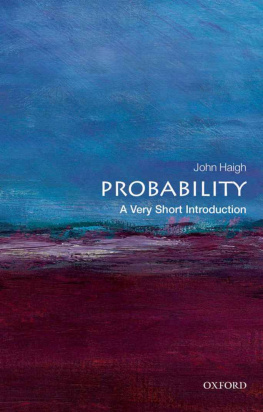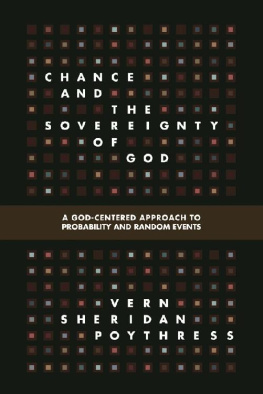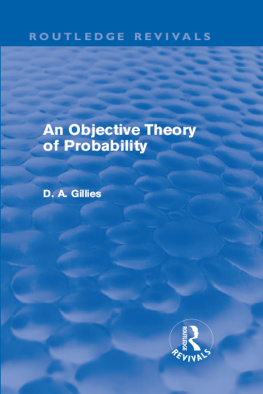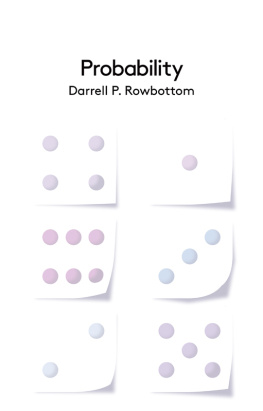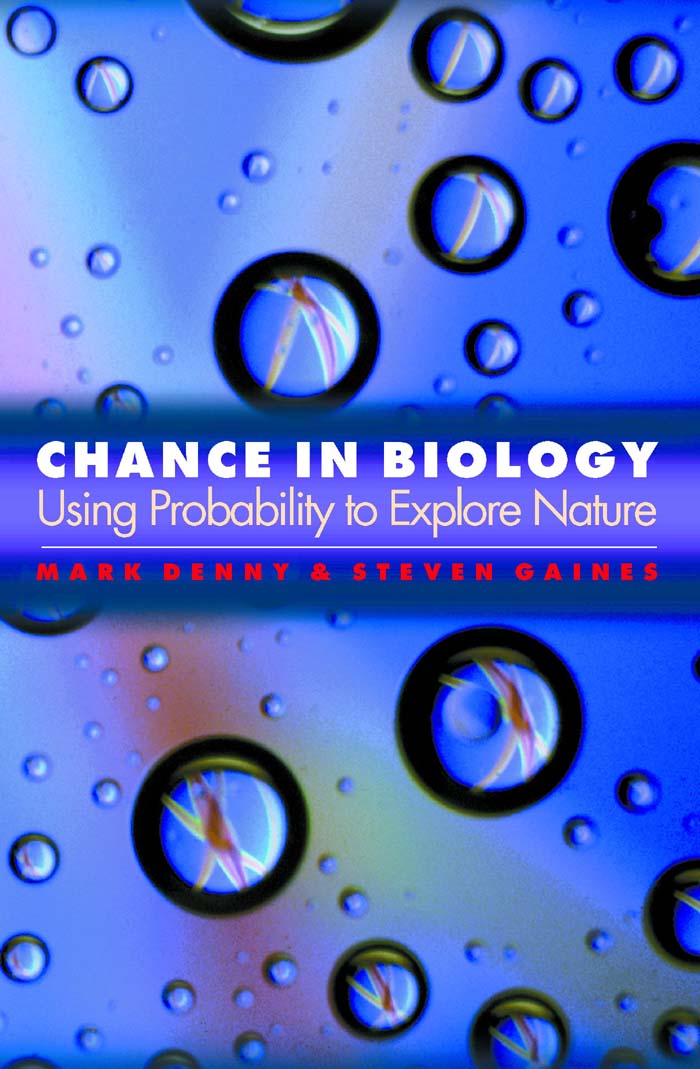Chance in Biology
Chance in Biology

Using Probability to
Explore Nature
Mark Denny and
Steven Gaines
Princeton University Press, Princeton and Oxford
Copyright 2000 by Princeton University Press
Published by Princeton University Press, 41 William Street, Princeton, New Jersey 08540
In the United Kingdom: Princeton University Press, 3 Market Place,
Woodstock, Oxfordshire OX20 1SY
All Rights Reserved
Library of Congress Cataloging-in-Publication Data
Denny, Mark W., 1951
Chance in biology : using probability to explore nature / Mark Denny and
Steven Gaines.
p. cm.
Includes bibliographical references.
ISBN 0-691-00521-4
1. Biomathematics. 2. Probabilities. I. Gaines, Steven, 1951 II. Title.
QH323.5 .D46 2000
570.15192-dc21 00-036687
This book has been composed in Times Roman
The paper used in this publication meets the minimum requirements of
ANSI/NISO Z39.48-1992 (R1997) (Permanence of Paper)
www.pup.princeton.edu
Printed in the United States of America
10 9 8 7 6 5 4 3 2 1

For my parents,
who are teaching me to be optimistic
when playing lifes odds.
M.D.
For Peggy, Erin, and Andrea,
for unvarying support and love.
S.G.
Contents
4 Continuous Patterns of Disorder
6.8 A Segue to Thermodynamics
9.3 Chapter 4
Preface
The basic idea for this book was hatched over a pitcher of beer at the 1992 Benthic Ecology Meeting in Newport, Rhode Island. After a day spent deciphering ANOVA tables as one ecologist after another grappled with the variability in his or her data, we were waterlogged with inferential statistics and in the mood to complain. It all seemed so pessimistic; scientists railing against the rising tide of natural fluctuation, everyone wishing that the world were just a bit more orderly. Wouldnt it be fun, we thought, to stop fighting the randomness of the real world and put all that variability to work? Maybe it was just the beer, but our commiseration eventually led to one of those cartoon moments in life when each of us could see a lightbulb suddenly illuminate over the others head. Stochastic processes could be our friend! And we were off and running.
Over the time that it has taken to write this text, we have had a lot of fun developing the idea that chance events can be used to make strong predictions about biology. Not the least of the enjoyment has been derived from those social encounters at meetings and parties in which a student or colleague asks the bland question, So, what are you working on these days? For seven years now, we have had the rare privilege of answering, Oh, Im writing a statistics text. The amusement comes when we watch the mental and facial contortions as the student or colleague fumbles for a courteous reply. Of course, to most biologists the obvious retort is, Why would anyone want to write a book on the driest subject known to man? but few people have been blunt enough to actually say so. The ensuing silences have allowed us to practice our sales pitch, and after several years of honing, we present it to you here.
Why Should You Read This Book?
For decades physicists, mathematicians, engineers, and fluid dynamicists have used the intrinsic stochastic nature of the world to their benefit. Through the application of the theory of probability, they have been able to make important predictions about how things work, and these predictions, embodied in rules such as the ideal gas laws and Ficks equations for diffusion, are standard tools in many areas of science and technology. A few areas of biology have embraced this approach (neurophysiology and population genetics come to mind), but the vast majority of biologists cling to the notion that in the advancement of science, the stochastic variability of nature is a bad thing. At the very least, it is annoying. How discouraging it must be to think that the random fluctuations of life serve primarily to obscure our knowledge of how life works. This intrinsically pessimistic approach is not made better by the standard biostatistics courses that are taught to undergraduates. These tend to be heavily laden with an endless list of statistical recipes, with scant attention paid to the theory of probability on which these recipes are based. No wonder most biologists think of statistics as desiccated and inscrutable.
To put this into the vernacular, we feel that it is time for biologists to stop being reactive in issues of natural variability; it is time to start being proactive. In this text, we hope to provide the reader with a sense of the good things that are possible when probability theory is applied to biology. If we are successful, you will come away with a glimpse of the joy to be had in bringing order out of chaos, the feeling of achievement in making an important biological prediction based on the intrinsic variability of nature.
What about All Those Equations?
These rewards cannot be had without some work on your part. There is no way around the fact that this is a mathematical textbook, and if you are like most biologists, the math might make you a bit uncomfortable. In structuring the text, we have tried to minimize this problem. First, this book is geared to an audience with a modest mathematical background. We assume that you have taken an introductory calculus course at some point in your career, but we do not assume that you use this knowledge on a day-to-day basis. In other words, we suppose that you know that the derivative of a function is equal to its slope, but we do not assume that you could readily calculate anything but the most basic derivatives. Similarly, we assume that you have a feeling that the integral of a function is equal to the area under the curve, but again we dont expect you to be able to calculate a complex integral.
Second, the mathematics in the book is gently progressive. We start off simply, then gradually move on to more challenging material. Wherever possible, we include intermediate steps in calculations and provide at least informal derivations so that you will know where the final, bottom-line equations come from. In the rare case where a derivation is just too complicated or technical to present here, we give reference to more specialized texts in which the full derivation can be found. If you forget what a symbol stands for, there is a separate index to direct you to the page on which that symbol is defined.
We hope that this approach will make this text accessible to a wide audience. Perhaps by working through the examples presented here you can knock some of the rust off your mental gears and rediscover how much fun a little math can be when applied to real-world problems. In case you care to test your understanding as you go along, we have included brief problem sets at the ends of chapters 2 through 8. Answers to the questions are provided in chapter 9, but you will be doing yourself a favor if you make an honest attempt to solve each problem first before consulting the cheat sheet.
This Book Is Not about Inferential Statistics
Finally, we feel compelled to warn you that this book is not a substitute for an introductory text on biostatistics. Hypothesis testing, error propagation, the analysis of variance, and correlation and regression analysis are all-important topics, but they are not covered here. We do provide an informal introduction to probability theory (a subject shared with the better texts on biostatistics), but then we take a different path, as outlined above. This is not to say that the approach taken here is at odds with that of inferential statistics. Indeed, we have for years used this text as an adjunct to courses in introductory statistics. The two viewpoints on stochastic processes are complementary, and we feel that you, the reader, can benefit from exposure to both.


